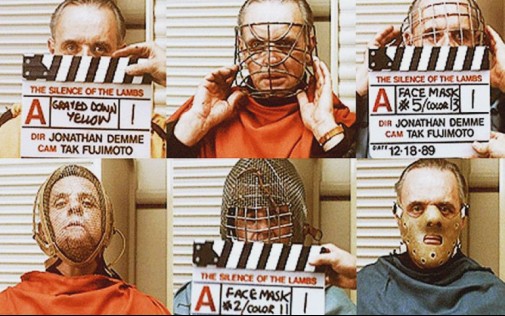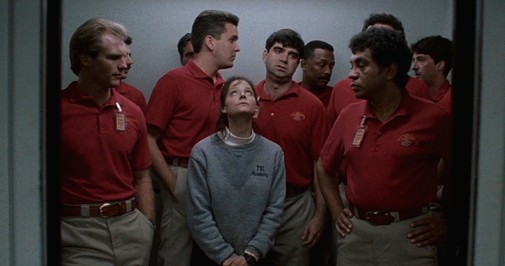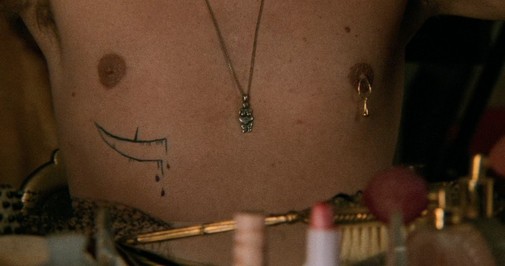Horror Costuming: The Silence of the Lambs (1991)
 Monday, October 18, 2021 at 9:00AM
Monday, October 18, 2021 at 9:00AM 
Jonathan Demme's horror masterpiece, the only film in the genre to win the Best Picture Oscar, has been written about ad nauseam since its release. And yet, some elements of The Silence of the Lambs remain under-discussed. It would seem impossible, but such is the richness of this feature. Take its design, iconic but understated enough to be taken for granted. The costumes are especially deserving of attention, going way beyond Lecter's mask and Buffalo Bill's world of human skin suits. They were designed by Colleen Atwood, a future favorite of the Academy, and represent an oft-forgotten part of her artistry - the ability to ground grotesquerie in reality and use clothing to define the relationships between people…

When The Silence of the Lambs was shot, Atwood was not nearly as well-known as she is today. By 1991, her only Tim Burton flick was Edward Scissorhands and the days of Oscar adoration were still far away. Looking at her filmography, one might surmise that Jonathan Demme chose her to costume The Silence of the Lambs based on the designer's work in Michael Mann's Manhunter, a previous adaptation of a Thomas Harris Lecter novel. However, the opposite was true. Demme explicitly wanted to avoid hiring the same people that had done that movie, and Atwood kept it from him as long as she could. Indeed, what recommended her was her work in Demme's Michelle Pfeiffer-starring Married to the Mob.
The jump from broad comedy to horror can seem bizarre, but the same basic philosophy unites the two projects as far as costume design is concerned. Rather than creating a visual spectacle for spectacle's sake or constructing characters as sartorial insularities, Atwood's work regards clothing as a reaction. We get to know the individuals and their world by how each person responds to an observing gaze. Whether one thinks of a mobster dynasty or a gaggle of FBI colleagues full of preconceived notions, perchance a psychopath, a mentor, or even the mirror's reflected gaze, that's irrefutably true. Jodie Foster's Clarice Starling is a particularly perfect example of fashion as a shape-shifting reaction.
In Harris's novels, Clarice is abstract. While most characters are detailly described, the FBI trainee is mostly imagined through her actions and how others, including many disgusting men, respond to her presence. We know she's petite, beautiful, and exudes maturity, but little more. The nature of conventional filmmaking means that Demme and company couldn't follow the same approach. Part of the wardrobe was obviously predetermined by the setting and her profession's official attire. Our very introduction to the character happens as she's clothed in the Quantico academy's workout gear, a sweaty grey sweater that somehow makes her look both fragile and formidable.
It's her second ensemble that packs more personality by expressing how she deals with tricky scene partners. Here, for the young woman's first meeting with Hannibal Lecter, Atwood dressed her in some pieces that will soon become a sort of uniform for Clarice. There's her earth-toned wool jacket and a beautiful green duffle coat. More specific to this scene, we have a crew-neck white blouse, probably her best one since we just see her wearing it again on graduation day. Its cut diverts attention from the chest, but the material is just thin enough for her bra to be visible when the light hits it just right.
More notably, she wears a pencil skirt for the only time in the movie, an attempt at formality and classic femininity that's further promoted by a delicate gold necklace and pearl studs. Not that the costume is a success for its wearer. Instead of putting forward an impenetrable shield, Clarice's sartorial smokescreen only inspires Lecter to punch through the charade with precise cold-readings that astonish with their accuracy. She's got a good bag and cheap shoes that Demme's camera never lingers over, allowing the murderer's assessment to guide our imagination. Maybe to follow that way of looking at Clarice, Atwood chose nondescript pieces, though it's notable that, like the skirt, Foster never again dons the brown leather heels. In subsequent scenes, the bag reapers.
While she never dresses conspicuously masculine nor avoids conventionally feminine lines, Clarice's costumes speak of a woman in a man's world, eager to sidestep unwanted attentions and unjust judgments. So it's no surprise that the codes of dress change when the character's in private casual conversation with her friend Adelia. When not sleuthing around in her watery palette of mossy greens and complementing maroons, Clarice resists the movie's humid atmosphere by putting on oversized warm sweaters and simple patterns. By illustrating the different ways in which Clarice presents herself, Atwood showcases her particular anxieties.
Another vital component of the leading lady's style is how she often rhymes with surroundings or particular characters. For example, Lecter's cold grey jumpsuit echoes a knitted scarf Clarice dons when it rains. More notably, the actress wears a cardigan with floral embroidery around the neck, always visible on closeup and in disturbing harmony with Buffalo Bill's home and his victim's closet. The detail calls attention to the gender dynamics present in the narrative and paints Clarice as a possible victim of the monster she chases. It's a strange choice for the movie's scariest sequence, but it works precisely because of how unintuitive it feels.
The other characters of The Silence of the Lambs are just as wonderfully costumed as Clarice. Brooke Smith's Catherine spends most of the movie wearing the rags her kidnapper gives her, but she first appears in a disturbingly humorous corduroy shirt with a fruity print. She's dressed as food, ripe for the taking by a voracious predator. Her on-screen mother is a senatorial vision of formal severity. One gets the notion that this is the sort of look Clarice was going for when meeting Lecter that first time, but there's a patrician exuberance to the older woman that feels too self-conscious. In the book, Senator Martin mulls over what to wear when confronting Lecter. There's a curated quality to the movie outfit that expresses that idea without needing an entire scene dedicated to it.
Speaking of outfits (and people) that fail to impress the famous cannibal, one must pay attention to Dr. Chilton. Lecter says Clarice has a little taste when describing her as a scrubbed-up rube, which is more than can be said for Chilton. One wonders what reticulated verbiage the cannibal would use to describe that man's tackiness which manifests as an overt need to impress. It's all in the clash of patterns that grow louder as the character gains more power over the prisoner. Upon meeting Senator Harris, he's got a scarf, a shirt, and a tie, all discordant with each other, plus a fur collar that makes him look a bit like a preening peacock. Compared to Jack Crawford's sharp three-piece suits, Chilton is positively dandyish.
And now, let's explore the monsters at the heart of The Silence of the Lambs. Many trans writers have argued for and against the transphobia of the on-screen depiction of Buffalo Bill, so I'll avoid commenting on the controversy. On the other hand, the murderer's costumes reveal a lot about their fractured psyche and predilections. They also emanate menace. Consider the projected masculinity of a satiny letterman jacket. Instead of a sports team iconography, the back's adorned with a flashy collection of touristy pictures of Japan. Other pieces reflect a fixation with Nipponic styles, like the kimono dressing gown Buffalo Bill wears for dancing in front of the camera. With arms open, the fabric reveals a patchwork of linings that recall stitched skin while the shape is that of a butterfly's wilted wings. Around the neck, a fertility goddess shines like a cruel objectification of the murder victims' bodies.
Finally, the character of Hannibal Lecter is as much a miracle of astute costuming as he is a superb Oscar-winning performance. What's most apparent when first meeting him is how pristine the man looks. Despite wearing a simple jumpsuit like the other prisoners in the ward, Lecter's outfit is tailored within an inch of its life, so perfectly fitted one gets a sense of his sophistication from just a glance. The teal-ish grey also surprises, perpetuating the movie's damp feel while circumventing the clichéd prison orange. He only wears that citrusy shade when he's playacting acquiescence and being rolled around by Chilton in a straight-jacket and mask.

The mask was a source of headaches for the costuming team, as many options were considered and screen-tested. Initially, grid-like constructions were chosen, taken from fencing equipment. However, as more versions were found, it became evident that something new would have to be designed from scratch. As a result, Atwood's final creation extrapolated from the idea of a hockey mask, a dehumanizing sculpture in fiberglass. When the prototype was completed, the designer fell in love with the raw color and texture of the material, thinking it both emulated flesh and leather. That's how one of horror cinema's most unforgettable props came to be.
That being said, the all-white outfit he wears when killing two guards is almost as instantly recognizable. Depending on who you ask, there are different versions of the pieces' origins. Hopkins has said it was his idea and that he had to convince Demme into going along with the clinical outfit. Other sources point to a sense of spirituality behind the color while the actor has, in later years, stated that his fear of dentists inspired the white costume. One thing for sure – The Silence of the Lambs wasn't the first time that Atwood dressed Hannibal in all-white. Manhunter showcased a similar color story. What differentiates the earlier costume from the 1991 version is, once again, the tailoring. The t-shirt and matching trousers fit Hopkins like a glove, denoting dangerous precision. White cotton also makes an excellent canvas for blood splatter.

In the end, though, Hannibal's most terrifying sartorial choice is also his most forgettable. Concluding the movie in pursuit of Chilton, the psychopath has foregone the tight lines of his prisoner persona and chosen to blend into the crowd. A sandy summer suit makes up his people costume, a mask of illusory normalcy that's perfectly accessorized with a jaunty hat, wig, and cool shades. It's the first time we can't see Hopkins' eyes as he speaks to Clarice, and the mechanism puts us in her shoes. As she listens, powerless, to Lecter on the phone, he's more unreadable than ever. Free at last, the monster's beyond her grasp and ours. It's a dapper note to end things on, a shot of casualness that chills to the bone. The devil shouldn't look so anonymous. That only makes him feel more dangerous.

The Silence of the Lambs is streaming on fuboTV. You can also rent it on various platforms.




















Reader Comments (5)
The movie deservedly won all of its five nominations at the Oscars, but it should have gotten way more nominations! Original score and cinematography too at least. Loved the costume too but it might a stretch knowing how stingy they are towards contemporary design.
When someone points me to something i'd overlooked is very refreshing,i'd never noticed that Clarice's blouse is see through and that Senator Martin suit screams power,Chilterns dress to impress clash of colours..
Excellent analysis of one of my top 10 films of all time.
I love the relationship we see between Ardelia and Clarice.
The observation that Catherine is attired in fruit prints ready for picking by the predator chilled me. I will never watch this film again without that detail foremost in my mind.
That is a nice-looking mangina.
I do like this film a lot but... I still prefer Manhunter over everything else.
Fadhil -- The Academy's reluctance to honor contemporary costume design will always vex me.
Mr Ripley79 -- Thank you for the kind words. Glad I could point out some things that had gone unnoticed. It's a very rich film, full of subtle unsettling details.
Finbar McBride -- It's such a pointed choice, especially since we only ever see it in close-up, as Buffalo Bill examines Catherine's skin. Kudos to Atwood.
thevoid99 -- MANHUNTER is also excellent. Love Cox's very distinct take on Hannibal and the sublime cinematography. For as much as I adore THE SILENCE OF THE LAMBS, Spinotti is unbeatable.